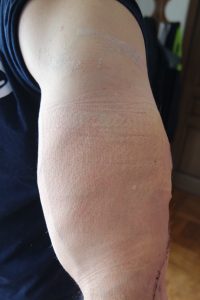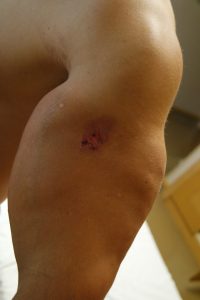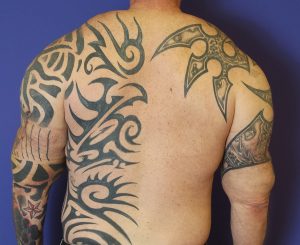
Paint-2) Pre-operative Picture-

Patient 2) Post-operative picture-

Patient 1) Immediatly after the second operation

Patient 1)before the surgery

Paint-2) Pre-operative Picture

Patient 2) Post-operative picture
PARAFFIN OIL REMOVAL SURGERY
Dr.Ruşer BARIŞ, Plastic,Reconstructive and Aesthetic Surgeon
Dream Clinique, Ankara, Turkey
Injection of foreign substances, such as paraffin oil, for the purpose of body contour augmentation has been used from the beginning of the last century. After severe destructive consequences of migrating parafin oil were recognized , the procedure has become obsolete in Western medicine. However, oil injections are still performed, either through self-injection or by unauthorised personnel. Adverse effects include skin inflammation, induration, sterile abscesses, fistulas, and skin rupture with suppuration of oily material(1). There are studies reporting complications after paraffin oil injections(2,3)
Paraffin injection also cause anemia, renal insufficiency, and severe hypercalcemia. In fact hypercalcaemia is quite common, usually caused by hyperparathyroidism, malignancy, or sarcoidosis, and can be life threatening. Granulomatous foreign-body reactions are rare but important in differential diagnosis. Calcium is normally tightly regulated by parathyroid hormones and vitamin D, which is converted to the active form, 1,25-dihydroxyvitamin D (calcitriol), by CYP27B1. In granuloma-induced hyper calcaemia, calcitriol production is catalysed by abnormal activity of CYP27B1 in inflammatory cells, particularly macrophages. This extrarenal activity does not appear to be regulated by classic feedback mechanisms, allowing calcitriol (and calcium ions) to rise to pathological levels(4).
There are many reports in the literature of self-injections of these and other materials which can be harmful to the human body. Commercial paraffin oil ( and an oil known by the brand name Johnson’s Baby) is reported to be applied on the cheeks, lips and chin. Consequent paraffinom makes the complete removal of the entire tissue necessary (5).
Di Benedetto et al.(2) report 26 cases with many complications resulting from illegal paraffin oil injection. These cases include women having injections into breasts for cosmetic purposes and men in the knee or elbow regions to avoid mandatory military service (in Italy). The main complications were inflammation, redness, skin stiffness and rupture, extrusion of oily material from pectoralis and joints and difficulty in performing limb flexion or extension.
The clinical features of paraffin oil injection are well known. The initial symptom is acute inflammation that occurs within 1 to 6 months after injection. Usually comes then a latent phase, during which the substance is tolerated. However, after a period of varying length reactions begin to appear. The paraffin oil is resistant to lysosymal enzymes in tissues and macrophages, and this leads to chronic granulomatous inflammation. This occurs in addition to other foreign body reactions. However the specific foreign body reaction peculiar to paraffin oil is the formation of fibrous tissue, which helps walling of the mineral oil, and separates it into small globules. This reaction may lead to skin induration, necroses and disfiguring subcutaneous nodules. The granulomatous tissue may further undergo suppuration and fistulae formation, giving rise to discharging sinuses. Mineral oil spreads and infiltrates soft tissues, consequently an area larger than the original oil injection area is often affected.
When possible, the most preferable treatment is complete resection of the affected tissue to prevent recurrence of adverse reactions(6,7). The surgical treatment should involve closure without tension and need to be partial. Conducting more than one intervention may be necessary.
It is not possible to remove the paraffin oil completely. This is because when paraffin oil is applied to arms it is injected partly inside the muscles and partly on the muscle surface too. The oil inside the muscles cannot be completely excised without risking serious damage.Therefore only the paraffin oil on (and around) muscles is removed almost completely as this can be done without damaging arteries, veins and nerves, and the oil inside the muscles is excised as much as possible depending on the particular anatomical circumstances.Our experience shows that after the operation the oil that is left inside the muscles gradually moves into the surface, and this requires to perform a second removal operation.
If paraffin oil injected into the arms is not surgically removed, it starts to spread after 4 to 7 years towards the forearm area and generates tissue damage, redness and skin stiffness, and chronic unhealing wounds.These are actually the most common long-term complaints reported by our patients. Moreoever all patients complain about lack of strength and feeling of heaviness in their arms. Another interesting pattern that we observe is that most of our patients suffer from kidney stones. Hypercalsemia may account for this correlation but to establish the exact mechanism behind the pattern further research by specialists is necessary.
Against this background, it is possible to state unequivocally that paraffin oil injection creates a medical condition that generates serious anatomical damage, and this renders surgical intervention a medical necessity.
Reference List
1) Compression Bandage as Treatment for Ulcers Induced by Intramuscular Self-injection of Paraffin Oil
Line Iversen, Asja Lemcke, Mikael Bitsch and Tonny Karlsmark
Department of Dermatology, Bispebjerg Hospital, Copenhagen University, Bispebjerg Bahke 23, DK-2400 Copenhagen, Denmark.
2) Di Benedetto G, Pierangeli M, Scalise A, Bertani A: Paraffin oil injection in the body: an obsolete and destructive procedure. Ann Plast Surg 2002,49:391–396.
3) Glicenstein J: The first “fillers”, vaseline and paraffin. From miracle to disaster. Ann Chir Plast Esthet 2007, 52:157–161.
4) Severe hypercalcaemia, nephrocalcinosis, and multiple paraffinomas caused by paraffin oil injections in a young bodybuilder. Gyldenløve M et al. Lancet 2014 Jun14;383:2098
5) De Gado F, Mazzocchi M, Chiummariello S, Gagliardi DN, Alfano C. Johnson’s baby oil, a new type of filler? Acta Chir Plast 2006;48:123-6.
6) Cohen JL, Keoleian CM, Krull EA. Penile paraffinoma: selfinjection with mineral oil. J Am Acad Dermatol. 2001;45(6 Suppl):S222-4. DOI: http://dx.doi.org/10.1067/mjd.2001.103995
7) Hazani R, Engineer N. Surreptitious injection of mineral oil: a case report of sclerosing lipogranulomatosis. Ann Plast Surg. 2008;61(5):555-8. PMID: 18948786 DOI: http://dx.doi.org/10.1097/ SAP.0b013e31816d8316





